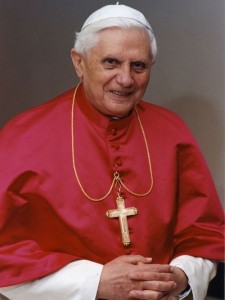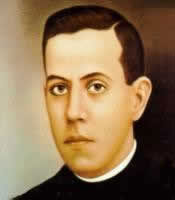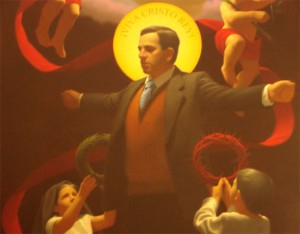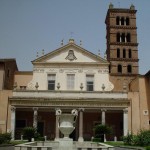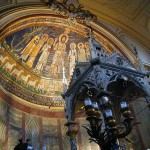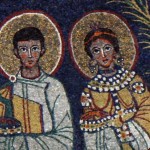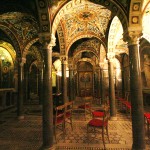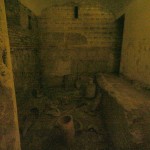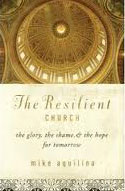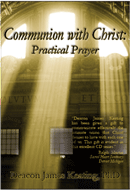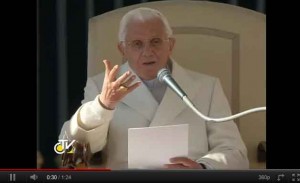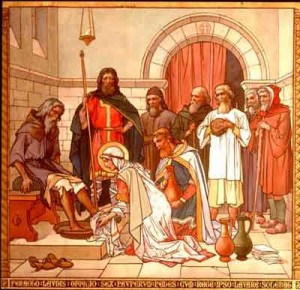“Only through such interior renewal will we be able to discern and meet the spiritual needs of our age with the ageless truth of the Gospel.”
[powerpress = “Vatican_Radio”]
Below, please find the full text and audio of Pope Benedict XVI’s remarks to the US Catholic bishops of Region II on Saturfday, November 26th, 2011
****************
Dear Brother Bishops,
I greet you all with affection in the Lord and, through you, the Bishops from the United States who in the course of the coming year will make their visits ad limina Apostolorum.
Our meetings are the first since my 2008 Pastoral Visit to your country, which was intended to encourage the Catholics of America in the wake of the scandal and disorientation caused by the sexual abuse crisis of recent decades. I wished to acknowledge personally the suffering inflicted on the victims and the honest efforts made both to ensure the safety of our children and to deal appropriately and transparently with allegations as they arise. It is my hope that the Church’s conscientious efforts to confront this reality will help the broader community to recognize the causes, true extent and devastating consequences of sexual abuse, and to respond effectively to this scourge which affects every level of society. By the same token, just as the Church is rightly held to exacting standards in this regard, all other institutions, without exception, should be held to the same standards.
A second, equally important, purpose of my Pastoral Visit was to summon the Church in America to recognize, in the light of a dramatically changing social and religious landscape, the urgency and demands of a new evangelization. In continuity with this aim, I plan in the coming months to present for your consideration a number of reflections which I trust you will find helpful for the discernment you are called to make in your task of leading the Church into the future which Christ is opening up for us.
Many of you have shared with me your concern about the grave challenges to a consistent Christian witness presented by an increasingly secularized society. I consider it significant, however, that there is also an increased sense of concern on the part of many men and women, whatever their religious or political views, for the future of our democratic societies. They see a troubling breakdown in the intellectual, cultural and moral foundations of social life, and a growing sense of dislocation and insecurity, especially among the young, in the face of wide-ranging societal changes.
Despite attempts to still the Church’s voice in the public square, many people of good will continue to look to her for wisdom, insight and sound guidance in meeting this far-reaching crisis. The present moment can thus be seen, in positive terms, as a summons to exercise the prophetic dimension of your episcopal ministry by speaking out, humbly yet insistently, in defense of moral truth, and offering a word of hope, capable of opening hearts and minds to the truth that sets us free.
At the same time, the seriousness of the challenges which the Church in America, under your leadership, is called to confront in the near future cannot be underestimated. The obstacles to Christian faith and practice raised by a secularized culture also affect the lives of believers, leading at times to that “quiet attrition†from the Church which you raised with me during my Pastoral Visit. Immersed in this culture, believers are daily beset by the objections, the troubling questions and the cynicism of a society which seems to have lost its roots, by a world in which the love of God has grown cold in so many hearts. Evangelization thus appears not simply a task to be undertaken ad extra; we ourselves are the first to need re-evangelization. As with all spiritual crises, whether of individuals or communities, we know that the ultimate answer can only be born of a searching, critical and ongoing self-assessment and conversion in the light of Christ’s truth. Only through such interior renewal will we be able to discern and meet the spiritual needs of our age with the ageless truth of the Gospel. (more…)
Tags: catholic, catholic podcast, catholic prayer, cathollc spirituality
This entry was posted on Saturday, November 26th, 2011 at 9:16 am
You can follow any responses to this entry through the RSS 2.0 feed.
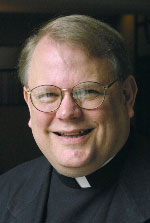 In this episode “Ars Celebrandi”, he explains how we are praying the Mass from the inside out.
In this episode “Ars Celebrandi”, he explains how we are praying the Mass from the inside out.
The New and Eternal Word, Monsignor James P. Moroney explores how the Church celebrates the Holy Mass in our day. In particular, he examines how a new Missale Romanum and a new English translation of these prayers can draw us more deeply into the words and rites of the Mass.
Tags: catholic, catholic podcast, catholic prayer, cathollc spirituality, Monsignor James P. Moroney, new mass translation
This entry was posted on Friday, November 25th, 2011 at 8:55 am
You can follow any responses to this entry through the RSS 2.0 feed.
Viva Cristo Rey
take a look…you won’t be disappointed
and maybe moved to learn about this extradodinary man…saint
According to one of Fr. Pro’s biographers, Rec. M.D. Forrest, M.S.C., the following was composed shortly before his death:
Does our life become from day to day more painful, more oppressive, more replete with afflictions? Â Blessed be He a thousand times who desires it so. If life be harder, love makes it also stronger, and only this love, grounded on suffering, can carry the Cross of my Lord Jesus Christ. Love without egotism, without relying on self, but enkindling in the depth of the heart an ardent thirst to love and suffer for all those around us: a thirst that neither misfortune nor contempt can extinguish… I believe, O Lord; but strengthen my faith… Heart of Jesus, I love Thee; but increase my love. Heart of Jesus, I trust in Thee; but give greater vigor to my confidence. Heart of Jesus, I give my heart to Thee; but so enclose it in Thee that it may never be separated from Thee. Heart of Jesus, I am all Thine; but take care of my promise so that I may be able to put it in practice even unto the complete sacrifice of my life.
Tags: Blessed Miguel Agust, Blessed Miguel Pro, catholic, catholic podcast, catholic prayer, cathollc spirituality, heart, Heart of Jesus, Jesus, Lord Jesus Christ, love, M.D. Forrest, martyr
This entry was posted on Wednesday, November 23rd, 2011 at 12:03 am
You can follow any responses to this entry through the RSS 2.0 feed.
St. Cecilia, her story is an extraordinary one of faithulness and commitment. Some would have you believe it was all “legend”, but the discovery of her incorrupt body in 1599 would bear otherwise. It seems to me the Lord is encouraging us to believe the witness of this courageous virgin martyr.
In St. Cecilia’s in Rome, Â I had one of the most peaceful and prayerful experiences while on pilgrimage to the “City of the Saints”.
It is said that Saint Cecilia was born of a patrician family in Rome and raised as a Christian. She wore a coarse horsehair garment beneath her clothes of rank, fasted, and vowed herself to God.
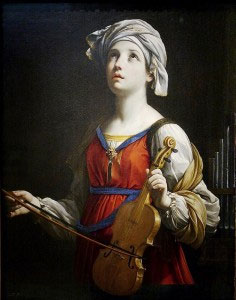 Against her will she was married by her father to a young, pagan patrician named Valerian. While everyone sang and danced at their wedding, Cecilia sat apart, saying only the Psalms. Valerian turned out to be a man of great understanding. On their wedding night, she told Valerian, “I have an angel of God watching over me. If you touch me in the way of marriage, he will be angry and you will suffer. But if you respect my maidenhood, he will love you as he loves me.”
Against her will she was married by her father to a young, pagan patrician named Valerian. While everyone sang and danced at their wedding, Cecilia sat apart, saying only the Psalms. Valerian turned out to be a man of great understanding. On their wedding night, she told Valerian, “I have an angel of God watching over me. If you touch me in the way of marriage, he will be angry and you will suffer. But if you respect my maidenhood, he will love you as he loves me.”
Valerian replied, “Show me this angel.” She told him that if he believed in the living and one true God and was baptized, he would see the angel. Thus, she persuaded Valerian to respect her vow of virginity.
He was impressed and attracted by his wife’s Christian graces, and so Valerian was baptized by Pope Saint Urban (which would be c. 222-230). When he returned to Cecilia, he found her standing by the side of an angel as she promised. The angel told him: “I have a crown of flowers for each of you. They have been sent from paradise as a sign of the life you are both to lead. If you are faithful to God, He will reward you with the everlasting perfumes of heaven.”
The angel then crowned Cecilia with roses, and Valerian with a wreath of lilies. The delightful fragrance of the flowers filled the whole house. At this point Valerian’s brother, Tiburtius, appeared. He, too, was offered salvation if he would renounce false gods. Cecilia converted him, and he was baptized.
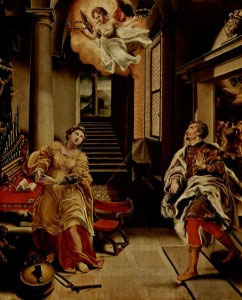 From that time the two young men dedicated themselves to good works. Because of their ardor in burying the bodies of martyred Christians, they were arrested. The prefect Almachius told them that if they would sacrifice to the gods, they could go free. They refused, and Valerian rejoiced when he was handed over to be scourged.
From that time the two young men dedicated themselves to good works. Because of their ardor in burying the bodies of martyred Christians, they were arrested. The prefect Almachius told them that if they would sacrifice to the gods, they could go free. They refused, and Valerian rejoiced when he was handed over to be scourged.
The prefect wanted to give them another chance, but his assessor warned him that they would simply use the interim to give away their possessions so that they couldn’t be confiscated. They were beheaded in Pagus Triopius, four miles from Rome. With them was an officer named Maximus, who had declared himself a Christian after witnessing their fortitude.
Cecilia buried the three and then decided to turn her home into a place of worship. Her religion was discovered and she herself asked to refute her faith. She converted those who were sent to convince her to sacrifice to the gods. When Pope Urban visited her at home, he baptized over 400 people.
In court, Almachius debated with her for some time. She was sentenced to be suffocated to death in the bathroom of her own house. The furnace was fed seven times its normal amount of fuel, but the steam and heat failed to stifle her. 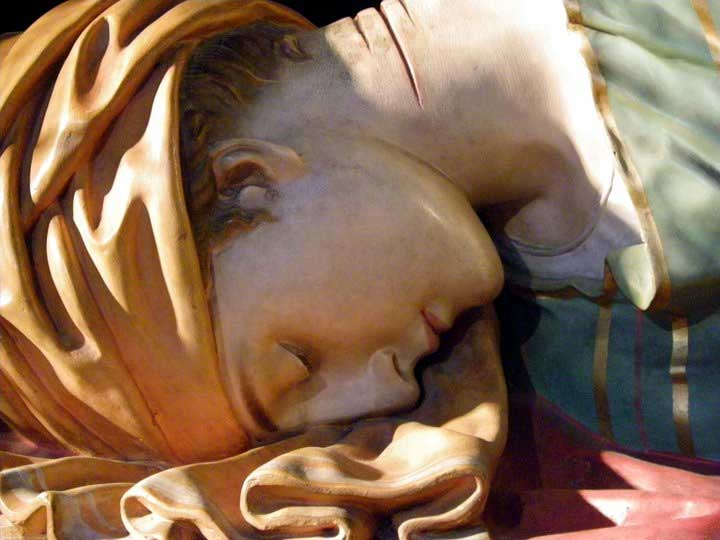 A soldier sent to behead her struck at her neck three times, and she was left dying on the floor. She lingered for three days, during which time the Christians thronged to her side, and she formally made over her house to Urban and committed her household to his care.
A soldier sent to behead her struck at her neck three times, and she was left dying on the floor. She lingered for three days, during which time the Christians thronged to her side, and she formally made over her house to Urban and committed her household to his care.
She was buried next to the papal crypt in the catacombs of Saint Callixtus. In 817, Pope Saint Paschal I discovered her grave, which had been concealed 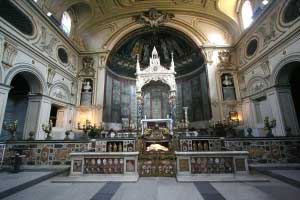 from the Lombard invader Aistulf in 756, and translated her body to beneath the main altar of what was later called the titulus Sanctae Caeciliae, which translates as “the church founded by a lady named Cecilia.” In 1599, during the renovation of the church, Cardinal Sfondrati opened her tomb and found her holy remains incorrupt. Even the green and gold of her rich robe had not been injured by time. Thousands had the privilege of seeing her in her coffin, and many have been blessed by miracles. The body disintegrated quickly after meeting with the air.
from the Lombard invader Aistulf in 756, and translated her body to beneath the main altar of what was later called the titulus Sanctae Caeciliae, which translates as “the church founded by a lady named Cecilia.” In 1599, during the renovation of the church, Cardinal Sfondrati opened her tomb and found her holy remains incorrupt. Even the green and gold of her rich robe had not been injured by time. Thousands had the privilege of seeing her in her coffin, and many have been blessed by miracles. The body disintegrated quickly after meeting with the air.
Under the high altar in Saint Cecilia’s Church is a beautiful marble statue by Maderna portraying the “martyr” bathed in her own blood as she fell after the stroke of the 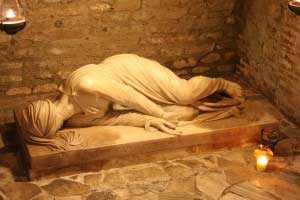 sword. A replica of this statue occupies the the original resting place of the saint in the catacomb of Callixtus. Other artists were allowed to paint pictures of her after her tomb was opened.
sword. A replica of this statue occupies the the original resting place of the saint in the catacomb of Callixtus. Other artists were allowed to paint pictures of her after her tomb was opened.
Until the middle ages, Pope Saint Gregory had been the patron of music and musicians, but when the Roman Academy of Music was established in 1584, it was put under the protection of Saint Cecilia; thus, her patronage of music originated. Dryden wrote a “Song for Saint Cecilia Day” and Pope an “Ode for Music on Saint Cecilia Day.”
Valerian, Tiburtius, and Maximus are historical characters; they were Roman martyrs, buried in the cemetery of Praetextatus, but nothing else is known of them. Her story was the basis for the Second Nun’s Tale in Chaucer’s Canterbury Tales.
St. Cecilia is regarded as the patroness of music [because of the story that she heard heavenly music in her heart when she was married], and is represented in art with an organ or organ-pipes in her hand.– From The Lives of the Saints by the Rev. S. Baring-Gould, M.A., published in 1914 in Edinburgh.
Dear Saint Cecilia, one thing we know for certain about you is that you became a heroic martyr in fidelity to your divine Bridegroom.
We do not know that you were a musician but we are told that you heard Angels sing.
Inspire musicians to gladden the hearts of people by filling the air with God’s gift of music and reminding them of the divine Musician who created all beauty.
Amen.
Tags: angel, catholic, catholic podcast, catholic prayer, cathollc spirituality, churches in rome, martyr, music, prayer, rome, st cecilia, valerian, virgin martyr, virginity
This entry was posted on Tuesday, November 22nd, 2011 at 12:32 am
You can follow any responses to this entry through the RSS 2.0 feed.
I love this feast day of the Blessed Virgin Mary!!!
The Presentation of the Blessed Virgin Mary (as it is known in the West), or The Entry of the Most Holy Theotokos into the Temple (its name in the East), is a liturgical feast celebrated by the Roman Catholic and Orthodox Churches.
wiki - The feast is associated with an event recounted not in the New Testament, but in the apocryphal
Infancy Narrative of James. According to that text, Mary’s parents, Joachim and Anne, who had been childless, received a heavenly message that they would bear a child. In thanksgiving for the gift of their daughter, they brought her, when still a child, to the Temple in Jerusalem to consecrate her to God. Mary remained in the Temple until puberty, at which point she was assigned to Joseph as guardian. Later versions of the story (such as the Gospel of Pseudo-Matthew and the Gospel of the Nativity of Mary) tell us that Mary was taken to the Temple at around the age of three in fulfillment of a vow.
The feast originated as a result of the dedication of the Basilica of Saint Mary the New, built in the year 543 by the Byzantines under Emperor Justinian I near the site of the ruined Temple in Jerusalem. Although this
basilica was destroyed by the Sassanid Persians under Khosrau II after the Siege of Jerusalem (614), the feast continued to be celebrated throughout the East. The feast was celebrated in the monasteries of Southern Italy by the ninth century and was later introduced into the Papal Chapel in Avignon in the year 1372 by a decree of Pope Gregory XI. Â It was included in the Roman Missal in 1472. But, as the fact of the “Presentation of the Blessed Virgin Mary” is only a pious belief, but not a defined matter of faith, it was suppressed by Pope Pius V in 1568. Â As a result, it did not appear in the Tridentine Calendar. Pope Sixtus V reintroduced it into the Roman Calendar in 1585. Pope Clement VIII made this feast a Greater Double in 1597. The
feast also continued as a memorial in the Roman Calendar of 1969.
Entry of the Most Holy Theotokos into the Temple (Russian icon, 16th century).The Eastern Orthodox Church celebrates it as one of its twelve Great Feasts on November 21 (for those churches which follow the Julian Calendar, November 21 falls on December 4 of the modern Gregorian Calendar). The first documented celebration of the feast in any calendar is the mention of the Εἴσοδος τῆς Παναγίας Θεοτόκου (Entry of the All-Holy Theotokos – i.e. into the Temple) in the 11th-century Menology of the Eastern Roman (also known as Byzantine) emperor Basil II. In the Orthodox Church the feast always falls during the Nativity Fast, and on the day of the feast the fasting rules are lessened somewhat so that fish, wine and oil may be eaten.
For the Roman Catholic Church, on the day of the Presentation of the Blessed Virgin Mary, “we celebrate that dedication of herself which Mary made to God from her very childhood under the inspiration of the Holy Spirit who filled her with grace at her Immaculate Conception.”
November 21 is also a “Pro Orantibus” Day, a day of prayer for cloistered religious “totally dedicated to God in prayer, silence and concealment.”
The Presentation in art
Western depictions usually focused on the lone figure of the young Mary climbing the steep steps of the Temple, having left her parents at the bottom, and climbing towards the Chief Priest and other Temple figures at the top of the steps. The Presentation was one of the usual scenes in larger cycles of the Life of the Virgin, although it was not usually one of the scenes shown in a Book of hours. – wiki
Collect: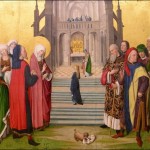
Eternal Father,
we honor the holiness and glory of the Virgin Mary.
May her prayers bring us
the fullness of your life and love.
We ask this through our Lord Jesus Christ, your Son, who
lives and reigns with You and the Holy Spirit,
one God, for ever and ever. Amen.
First Reading: Zechariah 2:14-17 (2:10-13 RSV)
Sing and rejoice, O daughter of Zion; for lo, I come and I will dwell in the midst of you, says the Lord. And many nations shall join themselves to the Lord in that day, and shall be My people; and I will dwell in the midst of you, and you shall know that the Lord of hosts has sent Me to you. And the Lord will inherit Judah as His portion in the holy land, and will again choose Jerusalem.”
Be silent, all flesh, before the Lord; for He has roused Himself from His holy dwelling.
Gospel Reading: Matthew 12:46-50
While He was still speaking to the people, behold, His mother and His brethren stood outside, asking to speak to Him. But He replied to the man who told Him, “Who is My mother, and who are My brethren?” And stretching out His hand toward His disciples, He said, “Here are My mother and My brethren! For whoever does the will of My Father in heaven is My brother, and sister, and mother.”
Tags: blessed virgin mary, catholic, catholic podcast, catholic prayer, cathollc spirituality, holy spirit, Holy Theotokos, prayer, presentation of the blessed virgin mary, Roman Catholic, silence, The Presentation of the Blessed Virgin Mary
This entry was posted on Monday, November 21st, 2011 at 12:07 am
You can follow any responses to this entry through the RSS 2.0 feed.
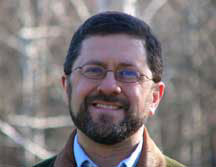 Episode 11– A Century of Cataclysms
Episode 11– A Century of Cataclysms
The Resilient Church with Mike Aquilina, offers a fascinating look at the trials and triumphs of the Catholic Church over the past two thousand years. Fast-paced sketches of critical periods in church history give readers perspective on the challenges faced by the church today. Mike Aquilina does not shrink from the realities of the past, including badly behaved leaders and those who betrayed the Lord. Yet he also leaves us all with well-founded hope for the future: God remains faithful in every circumstance and fulfills his promise to remain with his church always. Hosted by Kris McGregor
Also visit Mike’s “Discerning Hearts†page for more audio downloads and information!
Tags: catholic, catholic podcast, catholic prayer, cathollc spirituality, mike aquilina, Resilient Church
This entry was posted on Sunday, November 20th, 2011 at 10:56 pm
You can follow any responses to this entry through the RSS 2.0 feed.
Mark breaks open St. Paul’s letter to the Ephesians –
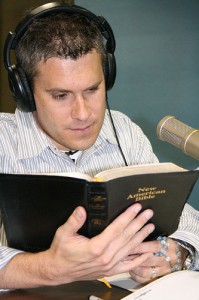
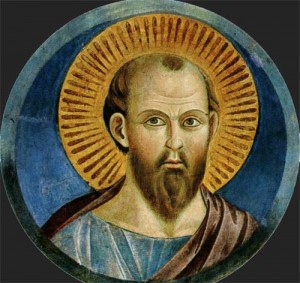 Exactly who was St. Paul writing to in his letter to the Ephesians? What was the purpose of the letter? Â What was the message? Â How does it apply to our lives today?
Exactly who was St. Paul writing to in his letter to the Ephesians? What was the purpose of the letter? Â What was the message? Â How does it apply to our lives today?
[powerpress]
Mark Hart is an author, speaker, director and teacher, Mark’s work both written and spoken, is known across the country and world. While he serves as the Vice President of LIFE TEEN, he is known to tens of thousands simply as the “Bible Geek ®†Mark passionately echoes the gospel to all he encounters. He is as deep as he is funny, and his love for his wife and daughters is second only to his immense love for Jesus Christ.
Visit Mark at www.lifeteen.com
Tags: catholic, catholic podcast, catholic prayer, cathollc spirituality, letter to the Ephesians, letter to the Ephesians Mark, lifeteen, mark hart, st. paul
This entry was posted on Sunday, November 20th, 2011 at 10:47 pm
You can follow any responses to this entry through the RSS 2.0 feed.
Michael O’Brien has gone beyond his previous work to bring us an incredible tale of love,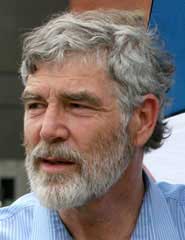 forgiveness…holiness.  “A Father’s Tale” is a pilgrim’s journey told in a way that stands up with greats like Tolkien and Lewis.  The prayerful reflection he pours into his work is born from his skill as a writer of icons.  Here, his pallette consists of  words, and he layers them as carefully as he does his works of art…in plot, character and storytelling.  “A Father’s Tale”  is deeply statisfying and leaves you desiring more.  Our conversation with Michael is is a wonderful one.  This is the book you’ll enjoy spending time with.
forgiveness…holiness.  “A Father’s Tale” is a pilgrim’s journey told in a way that stands up with greats like Tolkien and Lewis.  The prayerful reflection he pours into his work is born from his skill as a writer of icons.  Here, his pallette consists of  words, and he layers them as carefully as he does his works of art…in plot, character and storytelling.  “A Father’s Tale”  is deeply statisfying and leaves you desiring more.  Our conversation with Michael is is a wonderful one.  This is the book you’ll enjoy spending time with.
[powerpress]
“In this epic tale of the complex and mysterious workings of love, O’Brien takes his readers on a harrowing intercontinental odyssey, offering them an inside view both of brutal torture and mystical transport in which the dark incongruities of divine providence reorder faith and hope so that love becomes fully possible.”
– David Lyle Jeffrey, Ph.D.  Distinguished Professor of Literature and the Humanities, Baylor University
You can find the book here
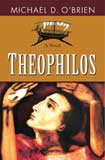 Be sure to check out the discussion with Michael about his book “Theophilos” on Inside the Pages #4
Be sure to check out the discussion with Michael about his book “Theophilos” on Inside the Pages #4
Tags: catholic, catholic podcast, catholic prayer, cathollc spirituality
This entry was posted on Sunday, November 20th, 2011 at 5:56 pm
You can follow any responses to this entry through the RSS 2.0 feed.
November 19, 2011. (Romereports.com) The pope visited a shelter that welcomes dozens of abandoned children, some of whom are sick or malnourished. It’s called “Peace and Joy,†and it’s run by the Missionaries of Charity in Benin.
Cotonou’s Archbishop and the Mother Superior welcomed the pope, while children sang and danced for Benedict XVI.
Another 800 people, many of them children, waited for the pope in the nearby church of St. Rita. There, the pope talked about the day of his First Communion.
Benedict XVI
“The day of my First Communion was one of the most beautiful days of my life.â€He also said that during Communion, one should be ready to “receive Jesus with love and attention.â€
Talking to others about God is also key, said the pope. He described it as a treasure that should be used generously. The pope then explained to children how he prays.
Benedict XVI
“I can also use the Gospels. That way, I keep within my heart a passage which has touched me and which will guide me throughout the day.â€When it comes to praying, the pope asked them to pray as a family. He also called on children to encourage their parents to pray together as a unit.
Benedict XVI
“Ask your parents to pray with you! Sometimes you may even have to push them a little. But do not hesitate to do so. God is that important.!†ÂThe pope also explained what a rosary is and how to pray it.
At the end of the gathering, the pope gave a rosary to each one of the children.
During the pope’s international trips he usually sets time aside to meet with underprivileged children.
Tags: benedict xvi, catholic, catholic podcast, catholic prayer, cathollc spirituality, pope, pope benedict xvi
This entry was posted on Saturday, November 19th, 2011 at 8:11 pm
You can follow any responses to this entry through the RSS 2.0 feed.
Episode 11 – Seeking Truth with Sharon Doran, hosted by Bruce McGregor. Â Ep 11 – John 20 “Making All Things New”
[powerpress]

Sharon Doran serves as the teaching director of “Seeking Truth.†An experienced Bible Study teacher, Sharon has a passion forscripture that will motivate and challenge you to immerse yourself in God’s Word and apply His message to your every day life.
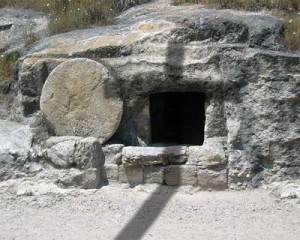 Episode 11 – Sharon and Bruce discuss John 20 – Â Old and New Testament meet in an extraordinary way.
Episode 11 – Sharon and Bruce discuss John 20 – Â Old and New Testament meet in an extraordinary way.
 “Seeking Truth†is an in depth Catholic Bible Study, commissioned by the Archdiocese of Omaha in response to John Paul II’s call to the New Evangelization as well as Pope Benedict XVI’s exhortation for all Catholics to study scripture. To learn more go to: www.seekingtruth.net
“Seeking Truth†is an in depth Catholic Bible Study, commissioned by the Archdiocese of Omaha in response to John Paul II’s call to the New Evangelization as well as Pope Benedict XVI’s exhortation for all Catholics to study scripture. To learn more go to: www.seekingtruth.net
Tags: catholic, catholic podcast, catholic prayer, cathollc spirituality, gospel of john
This entry was posted on Saturday, November 19th, 2011 at 7:59 pm
You can follow any responses to this entry through the RSS 2.0 feed.
Episode 4- Communion with Christ – Practical Prayer –  Continued reflections on the last things said by Jesus on the Cross.   Mary as teacher of prayer…the wellspring of interiority, because she held all the mysteries in her heart. “I Thirst”….God’s longing for us.  Allowing God to pray in us.  “My God, My God, why have you forsaken me”…is it more that we have abandoned God?  Sin looks like crucifixion.  The final words.
 Mary as teacher of prayer…the wellspring of interiority, because she held all the mysteries in her heart. “I Thirst”….God’s longing for us.  Allowing God to pray in us.  “My God, My God, why have you forsaken me”…is it more that we have abandoned God?  Sin looks like crucifixion.  The final words.
[powerpress]
Deacon James Keating, PhD, the director of Theological Formation for the Institute for Priestly Formation, located at Creighton University, in Omaha.
 From the Catechism of the Catholic Church paragraph 2605
From the Catechism of the Catholic Church paragraph 2605
When the hour had come for him to fulfill the Father’s plan of love, Jesus allows a glimpse of the boundless depth of his filial prayer, not only before he freely delivered himself up (“Abba . . . not my will, but yours.”),53but even in his last words on the Cross, where prayer and the gift of self are but one: “Father, forgive them, for they know not what they do”,54 “Truly, I say to you, today you will be with me in Paradise”,55 “Woman, behold your son” – “Behold your mother”,56 “I thirst.”;57 “My God, My God, why have you forsaken me?”58 “It is finished”;59 “Father, into your hands I commit my spirit!”60 until the “loud cry” as he expires, giving up his spirit.61
For more information on the “Institute of Priestly Formation†and for other material available by Deacon Keating, just click here
Don’t forget to pickup a copy of “Communion with Christ†, it is one of the best audio sets on prayer…ever!
Check out Deacon Keating’s “Discerning Heart†page
Tags: catholic, catholic podcast, catholic prayer, cathollc spirituality, Deacon James Keating, Deacon Keating, institute for priestly formation, prayer, theological formation
This entry was posted on Saturday, November 19th, 2011 at 7:43 pm
You can follow any responses to this entry through the RSS 2.0 feed.
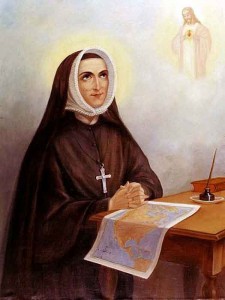  I’m not 100% comfortable with Father’s connection in the video above with St. Rose and failure…my gosh, she survived the French Revolution, traveled to a foreign and scary wilderness land, had difficulty learning English (which is a REALLY tough language to learn compared to the romance languages), and yet she persevered in educating and establishing a legacy of education which survives today…failure? I don’t think so, but you decide….
 I’m not 100% comfortable with Father’s connection in the video above with St. Rose and failure…my gosh, she survived the French Revolution, traveled to a foreign and scary wilderness land, had difficulty learning English (which is a REALLY tough language to learn compared to the romance languages), and yet she persevered in educating and establishing a legacy of education which survives today…failure? I don’t think so, but you decide….
Vatican.va -ROSE PHILIPPINE DUCHESNE Was born August 29, 1769 in Grenoble, France. She was baptized in the Church of St. Louis and received the name of Philip, the apostle, and Rose of Lima, first saint of the new continent. She was educated at the Convent of the Visitation of Ste. Marie d’en Haut, then, drawn to the contemplative life, she became a novice there when she was 18 years old.
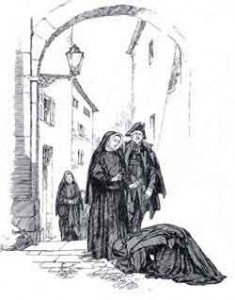 At the time of the Revolution in France, the community was dispersed and Philippine returned to her family home, spending her time nursing prisoners and helping others who suffered. After the Concordat of 1801, she tried with some companions to reconstruct the monastery of Ste. Marie but without success.
At the time of the Revolution in France, the community was dispersed and Philippine returned to her family home, spending her time nursing prisoners and helping others who suffered. After the Concordat of 1801, she tried with some companions to reconstruct the monastery of Ste. Marie but without success.
In 1804, Philippine learned of a new congregation, the Society of the Sacred Heart of Jesus, and offered herself and the monastery to the Foundress, Mother Madeleine Sophie Barat. Mother Barat visited Ste. Marie in 1804 and received Philippine and several companions as novices in the Society.
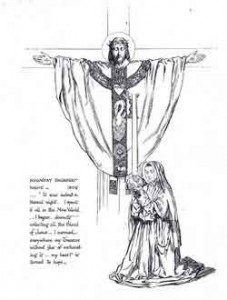 Even as Philippine’s desire deepened for the contemplative life, so too her call to the missions became more urgent – a call she had heard since her youth. In a letter she wrote to Mother Barat, she confided a spiritual experience she had had during a night of adoration before the Eucharist on Holy Thursday: “I spent the entire night in the new World … carrying the Blessed Sacrament to all parts of the land … I had all my sacrifices to offer: a mother, sisters, family, my mountain! When you say to me ‘now I send you’, I will respond quickly ‘I go”‘. She waited, however, another 12 years.
Even as Philippine’s desire deepened for the contemplative life, so too her call to the missions became more urgent – a call she had heard since her youth. In a letter she wrote to Mother Barat, she confided a spiritual experience she had had during a night of adoration before the Eucharist on Holy Thursday: “I spent the entire night in the new World … carrying the Blessed Sacrament to all parts of the land … I had all my sacrifices to offer: a mother, sisters, family, my mountain! When you say to me ‘now I send you’, I will respond quickly ‘I go”‘. She waited, however, another 12 years.
In 1818 Philippine’s dream was realized. She was sent to respond to the bishop of the Louisiana territory, who was looking for a congregation of educators to help him evangelize the Indian and French children of his diocese. At St. Charles, near St. Louis, Missouri, she founded the first house of the Society outside France. It was in a log cabin – and with it came all the austerities of frontier life: extreme cold, hard work, lack of funds. She also had difficulty learning English. Communication at best was slow; news often did not arrive from her beloved France. She struggled to remain closely united with the Society in France. (more…)
Tags: catholic, catholic podcast, catholic prayer, cathollc spirituality, french revolution, philippine duchesne, society of the sacred heart
This entry was posted on Friday, November 18th, 2011 at 12:06 am
You can follow any responses to this entry through the RSS 2.0 feed.
VATICAN CITY, 16 NOV 2011 (VIS) – During today’s general audience in St Peter’s Square, attended by over 11,000 pilgrims, the Holy Father imparted the final catechesis of his cycle dedicated to the Psalms. He focused on Psalm 110, which “Jesus Himself cited, and which the authors of the New Testament referred to widely and interpreted in reference to the Messiah. … It is a Psalm beloved by the ancient Church and by believers of all times”, which celebrates “the victorious and glorified Messiah seated at the right hand of God”.The Psalm begins with a solemn declaration: “The Lord says to my lord: ‘Sit at my right hand until I make your enemies your footstool”. Benedict XVI explained that “Christ is the Lord enthroned, the Son of man seated at the right hand of God. … He is the true king who by resurrection entered into glory, … higher than the angels, seated in the heavens over all other powers, … and with all His adversaries at His feet until the last enemy, death, is definitively defeated by Him”.God and the king celebrated in the Psalm are inseparably linked. “The two govern together, to the point that the Psalmist confirms that God Himself grants the regal sceptre, giving the king the task of defeating his adversaries. … The exercise of power is a task the king receivesdirectly from the Lord, a responsibility which involves dependence and obedience, thus becoming a sign to the people of God’s powerful and provident presence. Dominion over enemies, glory and victory are gifts the king has received, that make him a mediator of divine triumph over evil”.The priestly dimension, linked to that of regality, appears in verse four. “The Lord has sworn and will not change his mind ‘You are a priest forever, according to the order of Melchizedek'”. This priest, the king of Salem, had blessed Abraham and offered bread and wine following the victorious military campaign conducted by the patriarch to save Lot from the hands of his enemies. The king of the Psalm “will be a priest forever, mediator of the divine presence among His people, a catalyst for the blessing of God”. Jesus Christ “is the true and definitive priest, Who will complete and perfect the features of Melchizedek’s priesthood”. In the bread and wine of the Eucharist, Christ “offers Himself and, defeating death, brings life to all believers”.The final verses portray “the triumphant sovereign who, with the support of the Lord, having received power and glory from Him, opposes his enemies, defeating adversaries and judging nations”. (more…)
Tags: catholic, catholic podcast, catholic prayer, cathollc spirituality, pope benedict xvi, prayer, psalm 110, psalms
This entry was posted on Wednesday, November 16th, 2011 at 1:25 pm
You can follow any responses to this entry through the RSS 2.0 feed.
.
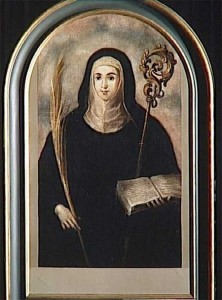 see also Pope Benedict’s teachings on St. Gertrude on the Discerning Hearts Holy Women page
see also Pope Benedict’s teachings on St. Gertrude on the Discerning Hearts Holy Women page
(1256-1302 A.D.) Few men have merited the title, “the Great”; fewer women. I know of only one nun so honored, St. Gertrude of Helfta, a mystic whose spiritual writings have remained influential up to the present.
Nothing is known of this German woman’s family background. When five years old, she was entrusted to the sisters of Helfta Abbey to be educated. From a very young age she gave evidence of her brilliance and quickly outstripped her companions. In her teen years she asked to join the community. Therefore, she probably spent her whole life from childhood on within the abbey walls.
Her love for secular studies made the common life wearisome, pride and vanity ate away at her soul and she soon became an unhappy young woman until Christ appeared to her. The day was branded in her memory, it was in her 26th year, when as she says “in a happy hour, at the beginning of twilight, thou O God of truth, more radiant than any light, yet deeper than any secret thing, determined to dissolve the obscurity of my darkness.” From then on her biographer tells us “she became a theologian instead of a grammarian.” She did not give up her intellectual ardor but now, all her labors were for her sisters, to cure what she termed “the wound of ignorance”. Her many gifts and mystical graces did not prevent her from giving herself wholeheartedly to the common life with its joys and sorrows. In fact many of her special graces came to her as she took part in the ordinary routine of convent life. She felt keenly for those whose burdens involved them in distracting duties, for example those responsible for meeting the debts of the monastery.
She prayed that they might have more time to pray and fewer distractions. The Lord’s answered “It does not matter to me whether you perform spiritual exercises or manual labor, provided only that your will is directed to me with a right intention. If I took pleasure only in your spiritual exercises, I should certainly have reformed human nature after Adam’s fall so that it would not need food, clothing or the other things that man must find or make with such effort.”
Many of her writings are lost, but fortunately she left to the world an abundance of spiritual joy in her book The Herald of Divine Love, in which she tells of the visions granted her by our divine Lord. She wrote this excellent, small book because she was told that nothing was given to her for her own sake only. Her Exercises is an excellent treatise on the renewal of baptismal vows, spiritual conversion, religious vows, love, praise, gratitude to God, reparation, and preparation for death.
She began to record her supernatural and mystical experiences in what eventually became her Book of Extraordinary Grace (Revelation of Saint Gertrude), together with Mechtilde’s mystical experiences Liber Specialis Gratiae, which Gertrude recorded. Most of the book was actually written by others based on Gertrude’s notes. She also wrote with or for Saint Mechtilde a series of prayers that became very popular, and through her writings helped spread devotion to the Sacred Heart (though it was not so called until revealed to St. Margaret Mary Alocoque).
Gertrude is inseparably associated with the devotion to the Sacred Heart. The pierced hear
t of Jesus embodied for her the Divine Love, an inexhaustible fountain of redemptive life. Her visions and insights in connection with the Heart of Jesus are very enlightening. In one such intellectual vision, she perceived the unceasing love of Christ for us in two pulsations of his Heart – one accomplished the conversion of sinners, the other the sanctification of the just. Just as our own faithful heart keeps right on whether we advert to it or not, these pulsations will endure till the end of time despite the vicissitudes of history.
Our Lord wishes people to pray for the souls in purgatory. He once showed Gertrude a table of gold on which were many costly pearls. The pearls were prayers for the holy souls. At the same time the saint had a vision of souls freed from suffering and ascending in the form of bright sparks to heaven.
In one Vision, Our Lord tells Gertrude that he longs for someone to ask Him to release souls from purgatory, just as a king who imprisons a friend for justice’s sake hopes that someone will beg for mercy for his friend. Jesus ends with:
“I accept with highest pleasure what is offered to Me for the poor souls, for I long inexpressibly to have near Me those for whom I paid so great a price. By the prayers of thy loving soul, I am induced to free a prisoner from purgatory as often as thou dost move thy tongue to utter a word of prayer.” (more…)
Tags: benedictine, catholic, catholic podcast, catholic prayer, cathollc spirituality, devotion, family, jesus christ, love, mystic of the Church, mystical experiences, sacred heart, sacred heart of jesus, spiritual exercises, spiritual writings, st gertrude, women of the middle ages
This entry was posted on Wednesday, November 16th, 2011 at 2:30 am
You can follow any responses to this entry through the RSS 2.0 feed.
A Queen of Scotland!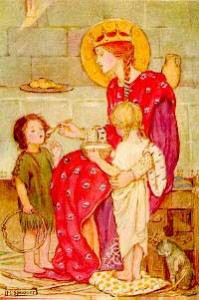
Margaret was born c. 1045 and was the niece of King Edward the Confessor of England. She was raised in Hungary and lived with her exiled father, Edward Atheling, her mother, Agatha, her brother, Edgar, and her sister, Christian. They returned to England in 1054. Early chronicles tell us that she read the scriptures in Latin, learned French and was trained in English needlework.
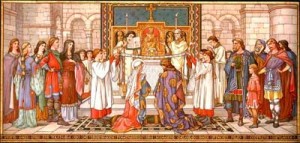 Marriage of St Margaret
Marriage of St MargaretMargaret married Malcolm III ‘Canmore’ of Scotland in c.1070. Margaret would have been about 24 years of age and Malcolm about 47. Ancient chronicles tell us that Margaret was more prepared for the cloister than the crown. However, Malcolm won her over and they were married in Dunfermline, then the seat of the Scottish kings.
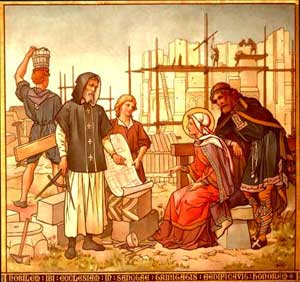
Margaret had a significant influence on early Scotland. Although she was a patron of the existing celtic church, she also introduced to Scotland the Benedictines from Canterbury and had the Priory Church built which would eventually become Dunfermline Abbey. Margaret also had a chapel built at Edinburgh Castle and the church at Iona rebuilt after Viking attacks.
Washing the feet of the poor
Margaret was very pious and carried out many works of charity. She visited and cared for the sick and had hostels built for the poor. It was her custom that the poor should visit her every morning and be seated around her to receive alms. (more…)
Tags: benedictine, catholic, catholic podcast, catholic prayer, cathollc spirituality, celtic church, england, Malcolm III, mother, scotland, st margaret, St Margaret Margaret, St. Margaret of Scotland, women of the middle ages
This entry was posted on Wednesday, November 16th, 2011 at 12:04 am
You can follow any responses to this entry through the RSS 2.0 feed.

